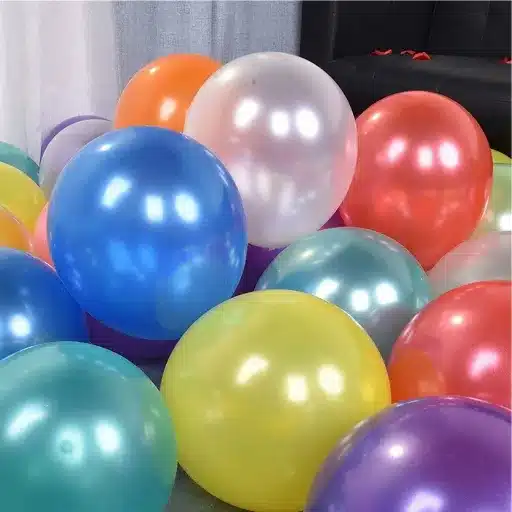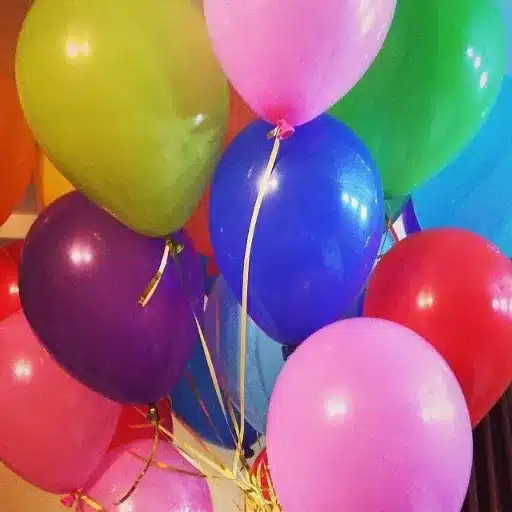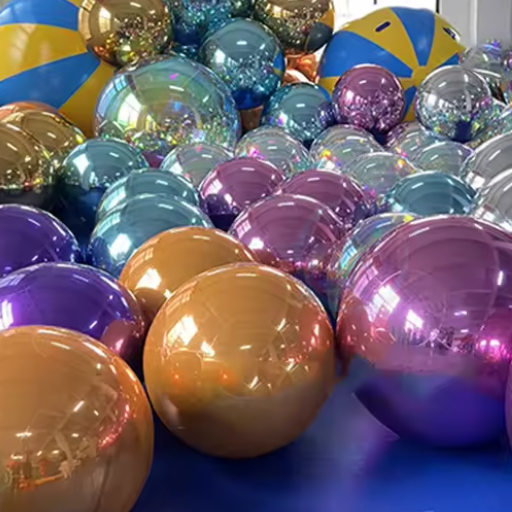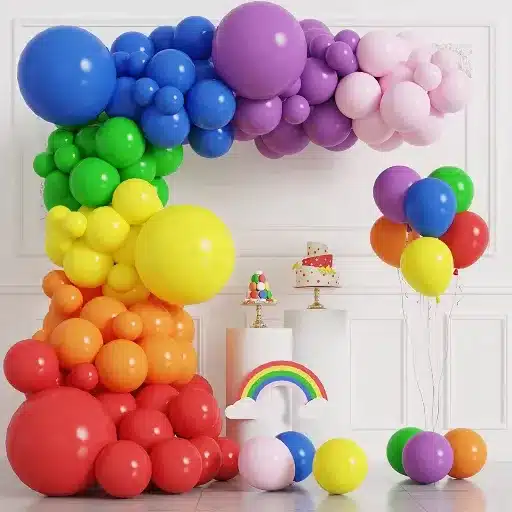Balloons are an everlasting addition to the celebrations, bringing with them the so-called colors, joy, and the vibe of festivity among others to every occasion. However, in case you are going to throw a party or celebrate a special day, you might be curious about the actual lifespan of these bright and cheerful decorations. Do helium balloons remain up for several days or only a few hours? Are latex balloons more delicate than their foil counterparts? The factors that affect the lifespan of helium-filled and latex balloons will be discussed in this article along with some tips for extending their life and event planning assistance. Stay with us to find out how to keep the glow of these floating charms present for a longer time!
Introduction to Helium Balloons

According to what I have learned, helium balloons that are made of latex last about 8 to 12 hours at the most while foil balloons may last up to three or even four weeks. Latex balloons are lighter and have bigger openings for helium to escape faster while foil balloons are heavier and have less porosity making them last longer.
The Importance of Knowing Balloon Lifespan
The lifespan of the helium balloons filled with latex is to be understood first and foremost when events are being planned and thus when decorations are carried out and a truly magical atmosphere created. Roughly speaking, through the use of helium-filled latex balloons, one can expect a floating duration of about 12 to 24 hours at most, whereas balloon foil (or Mylar) is definitely staying up longer, quite often lasting for days and in some cases even a week or two if conditions are really good. All the above-mentioned factors, namely room temperature, humidity, and proper handling contribute a lot to balloon lifespan.
Trends show that “how long do helium balloons last” is one of the most common searches around holidays and events from New Year to Christmas, birthdays, and weddings, indicating the public’s desire to get their decorations done at the right time. Treatment of latex balloons with Hi-Float – a coating for the entire balloon – is one of the methods which can prolong their float time for up to a week. Furthermore, making sure the balloons are kept away from direct sunlight, sharp objects, and extreme temperatures will go a long way in delaying their deflation.
Latex balloons vs Foil balloons
Parties and Celebrations
Every child dream of a fairy-tale birthday with lots of balloons and showered with attention. Even adults enjoy it as they get to be kids for just that moment. Helium balloons not only bring visually but also physically. They are a huge part of the party scene and can even be personalized to the event’s messages, colors, and designs. So, no wonder “balloons birthday” is one of the top searches related to helium balloons which indicate that they are popular for celebrations.
Corporate Events and Promotions
Airy designs with helium balloons are also intended for business branding and marketing. Trade shows, product launches, and store openings are places where custom-printed balloons with logos or messages are often used. Studies show that the captivating helium balloon displays can lead to a 25% increase in the number of visitors to booths or stores such.
Advertising and Outdoor Promotions
Giant helium balloons and blimps are often used for promoting products or services through outdoor ads due to their high visibility from afar. It has been revealed through research that inflatable advertising is the most effective visual impact creator and thus the companies reporting an average of 15% increase in brand recall have attributed the reason to having the ability to create a vivid and memorable visual impact.
Helium Balloons Types

Latex balloons vs Foil balloons
1. Material Composition:
While latex balloons are made of natural rubber that allows them to degrade easily and be less harmful to the environment, foil balloons consist of a very thin layer of metalized plastic (also referred to as Mylar) which is not biodegradable and hence, if not disposed of correctly, is more of an environmental concern.
2. Duration:
The lifespan of a helium latex balloon is about 8 to 12 hours in an indoor setting as helium can pass through the small pores present in the latex. Yet, treated latex balloons can last for 1-2 days or even more. Foil balloons being less porous can hold helium for a much longer time, usually up to 5-7 days or longer.
3. Appearance and Customization:
Latex balloons are available in assorted colors and can be formed into various shapes by stretching or molding, thus being quite flexible in terms of creative arrangements. They also allow the printing of logos and designs. On the other hand, foil balloons have a bright, shiny, metallic look and come in predefined shapes (like stars, letters, or themed characters), which give a more refined look for themed occasions.
Average Float Times for Latex Balloons

Latex balloons are a commonly used option for parties and events, but their float times are influenced by a number of factors such as size, helium quality, and the application of a preservative like Hi-Float. As a general rule, an untreated 11-inch latex balloon filled with helium can float for 8-12 hours. However, treated latex balloons of the same size can last up to 24-48 hours by preventing helium from escaping.
The following is a summary of average float times for common latex balloon sizes:
| Balloon Size | Untreated Float Time | Treated Float Time |
|---|---|---|
| 9-inch latex balloons | 6-10 hours | Up to 24 hours |
| 11-inch latex balloons | 8-12 hours | 24-48 hours |
| 16-inch latex balloons | 12-24 hours | Up to 2-3 days |
| 3-foot latex balloons | — | Up to 3-5 days (especially when treated) |
💡 Pro Tip: These times are greatly influenced by environmental factors like temperature, humidity, and sunlight exposure. For prolonging float life, it is best to keep balloons in a cool, indoor location and out of direct sunlight or heat extremes.
Factors Affecting Helium Balloon Lifespan

Environmental Influences on Balloons
- 🌡️ Temperature:
When the temperature is very high, helium will be forced to expand and this is the most probable reason for the balloons bursting. On the other hand, cold temperatures will have the opposite effect on helium and the balloon will look deflated. The best temperature range for helium balloons is between 65°F and 72°F (18°C and 22°C).
- 💧 Humidity:
High humidity can make the latex of the balloons weak, affecting their structural integrity and floatation life. Water is the main enemy of foil balloons as they could still be losing helium faster in humid conditions.
- ☀️ Direct Sunlight and UV Exposure:
Sunlight and UV rays degrade latex materials in the same way as heat does and this makes balloons to be brittle and burst easily. Tests have proved that latex balloons can be completely ruined if left in direct sunlight for only 1 to 2 hours while foil balloons may still survive for a little longer because of their shiny surface.
How Balloon Material Affects Float Time
The way a balloon is made has a great bearing on how long it will float; this is because the various materials have different types of systems when interacting with helium and that particular surrounding environment. For example, latex balloons are a type of porous material that is why helium can escape through the tiny holes found in them. As a rule of thumb, untreated latex balloons can rather float for a maximum of 8 to 12 hours. This time can be increased to 2 to 3 days if a sealant like Hi-Float is applied which builds a wall to inhibit the passing of helium.
Mylar or Foil balloons, on the contrary, are less porous and keep helium a lot longer. A normal 3 to 5-day floatation period is given to these balloons, with the possibility of a week as maximum time under perfect conditions. But, on the side of heat, exposure can lead to the venting of gas, and thus the stress cracking of the balloon while, on the side of cold, it may cause the gas shrinking and the appearance of the balloon as partially deflated.
Tips to Extend the Life of Helium Balloons

In order to prolong the life of helium balloons, I keep them inside in a cool room, not too near to the sun or heat sources, thus avoiding causing them to expand and burst. Moreover, I do not expose them to cold, as this may lead to deflation earlier than expected.
Best Practices for Inflation
Use the Right Amount of Helium
Over-inflating balloons or under-inflating them can lead to a decrease in both their float time and safety, that is, bursting. In case of latex balloons, inflate them nearly to 90 percent of their full capacity unless the manufacturer indicates otherwise. For foil balloons, fill them until the surface is tight and smooth, and do not apply more pressure than that to avoid tearing or breaking them.
Measure Sizes of Inflated Balloons for Consistency
You can use sizing templates or guides to hold you the balloons uniformly. For instance, an 11-inch latex balloon that is inflated correctly could normally stay afloat for 12 to 16 hours while a bigger balloon (i.e. 16-inch) with helium could last up to 24 to 30 hours and still be floating.
Add a Hi-Float Treatment
The Hi-Float solution can be put inside latex balloons before they are inflated, which is one method of extending float time. This solution can double or triple float times if applied properly. For instance, an 11-inch latex balloon without Hi-Float might stay afloat for 12 hours, and with Hi-Float, it might last up to 48 hours.
Storage and Handling Tips
I am convinced that the helium-filled balloons’ proper registration, storage, and handling can last longer. In the case of pre-use storage, keep balloons in a cool, dry place away from direct light and hot places. The impact of heat is that helium expands, hence one has to be careful not to cause premature bursting of balloons due to their being already overwhelmed with helium. It is also a good practice to store balloons at a temperature of around 70°F (21°C) to support their live span.
In the case of being handled, do not use sharp objects or touch abrasive surfaces as the high-quality balloon material may get punctured. For this reason also, use a good helium tank with a faucet that regulates the flow of gas, thus preventing filling balloons too much. A study has shown that latex balloons can maintain helium in their material for a period of 12-24 hours while foil balloons can go, depending on the conditions, for 2-5 days or even longer. If you are looking to get an even more extended float time, you might want to consider applying a balloon sealant whose function is to make latex balloons less permeable to helium gas.
Conclusion and Practical Advice

Care of Helium Balloons Final Thoughts
Making the right choice in helium balloon care is a prerequisite for the extended life and visual attraction of your events. Not only that, but scientific research and the development of new materials have come to the conclusion that the application of a sealant like Hi-Float to balloons can significantly increase their float time, with the extension going as high as 25 times for latex balloons. For example, an average balloon filled with helium and made from latex will usually remain afloat for 8-12 hours, but once treated with Hi-Float, it can even stay for several days in very perfect conditions.
Moreover, the temperature and humidity are other factors that affect balloon-maintaining very much. Being in a very hot place where the heat is high can lead to popping due to helium expansion, while the opposite is true for cold conditions where gas contraction occurs leading to loss of buoyancy. The researchers recommend that the life of helium-filled balloons is best when they are placed in indoor air-conditioned rooms with a controlled temperature of about 68-72°F or 20-22°C.
Reference Sources
-
Party On Butler Blog
- Title: How Long Do Helium Balloons Last? Tips for Balloon Decor
- Summary: This blog provides detailed insights into the float time of helium balloons, including tips for prolonging their lifespan, making it a practical resource for event planners and party hosts.
-
Boxwood Rose Blog
- Title: How Long Do Helium Balloons Last?
- Summary: This source explains the lifespan of different types of helium balloons (latex, foil, and bubble balloons) and offers advice on using products like Hi-Float to extend their longevity.
-
Balloon Training Institute Blog
- Title: How Long Do Helium Balloons Stay Inflated? Key Tips for Balloon Decor
- Summary: This blog discusses the inflation duration of helium balloons and provides key tips for maximizing their float time, making it a valuable resource for both professionals and DIY enthusiasts.
Frequently Asked Questions (FAQs)
❓ What Is the Average Lifespan of Helium Balloons?
The lifespan of helium-filled balloons on average depends on the kind of balloon used. On the other hand, the latex helium balloons make for a party and the ones that are used for decorations last only between 12 to 24 hours, while mylar balloons that are thicker and made of metallic materials can stay floating for days and even weeks. Weather factors like temperature and humidity will have a bearing on the lifespan of helium-filled balloons.
❓ How Long Will Helium Balloons Float Before They Deflate?
Helium-filled balloons will typically stay floating for a few hours to a day at maximum, after which they will start to deflate. The material of the balloon has a lot to do with the time of the float. The porous latex balloons will lose their helium faster than the non-porous mylar ones, thus leading to a shorter float time.
❓ What Factors Affect the Float Time of Helium Balloons?
The float time of helium balloons can be affected by a number of factors. The most important factor is temperature; hot weather can cause the helium to expand and escape quicker. Besides, the thickness of the balloon material and the quality of the seal may also determine how long the helium remains in the balloon.
❓ How Can I Extend the Lifespan of My Helium Balloons?
Several techniques can be employed to prolong the helium balloons’ lifespan. For instance, a cool, shaded place away from direct sunlight can be their permanent abode and that might help prolong the duration of helium confinement to some extent. Besides, if you treat your latex balloons with a specially formulated aerosol spray it can serve as a barrier that slows down the process of helium going out, thereby giving your balloons a longer life.
❓ Can Helium Balloons Last Longer in Cold Temperatures?
Balloons filled with helium can indeed last longer if kept in cooler temperatures. The reason being, the cooler the temperature, the slower the helium escape rate from the balloon which consequently prolongs the float time. On the other hand, extreme cold might make the balloon’s material brittle, thus, leading to wear and tear.
❓ How Do Different Types of Balloons Compare in Terms of Float Time?
The float time of helium-filled balloons in the case of latex balloons is generally very short when compared to mylar balloons. Latex balloons would hardly last past the 24-hour mark while mylar balloons would be around for several days. If you are considering balloons for a party, the choice of mylar over latex will guarantee the inflating effect lasts longer.










